I hear the question a lot, and it’s a good one.
In my garden, I use mixes based on the species I’m growing and my development goals for the tree. I make adjustments for the health of the tree, my budget, and the availability of the ingredients I’d like to use.
If I’m working with trees in other people’s collections, I ask about the conditions in which the trees grow. This includes the climate, sun or wind exposure, and whether the trees are more likely to be overwatered or underwatered on a regular basis.
The answers to these questions provide all of the information I need to get started.
Refined bonsai – conifers and deciduous species
When I’m working with refined bonsai or trees where the main goal is to improve branch development, I start by identifying a target percentage of akadama to use.
- For most conifers, I use between 30% – 60% akadama
- For most deciduous species, I use between 50% – 80% akadama
Within these ranges, I make some adjustments. I use less akadama:
- When trees are sick or when I want to increase vigor
- When trees are more likely to be overwatered
I use more akadama:
- When I want the tree to produce slower growth or shorter internodes
- When trees are more likely to be underwatered
For the non-akadama portion of the mix, I use straight pumice or occasionally a mix of pumice and lava rock.
Although pumice and lava rock have different water holding characteristics, I have yet to see enough of a difference between pumice and akadama mixes, lava rock and akadama mixes, or mixes of pumice, lava rock, and akadama to make a strong recommendation one way or the other.
One reason for this is that there is great variation among volcanic soils like pumice and lava rock. As mined products, the color, shape, and density can vary greatly from mine to mine or from the surface of a given vein within a mine to the lower depths of the same vein.
For example, the Japanese pumice used for bonsai is yellow in color compared with the white pumices mined across North America. Its surface is relatively smooth compared with the crenulated, irregularly shaped particles found in some North American mines.
Despite these differences, I have yet to see enough difference among tree health and root development to make strong recommendations for one kind of pumice over another. Japan has been able to create beautiful and healthy trees with Japanese pumice.
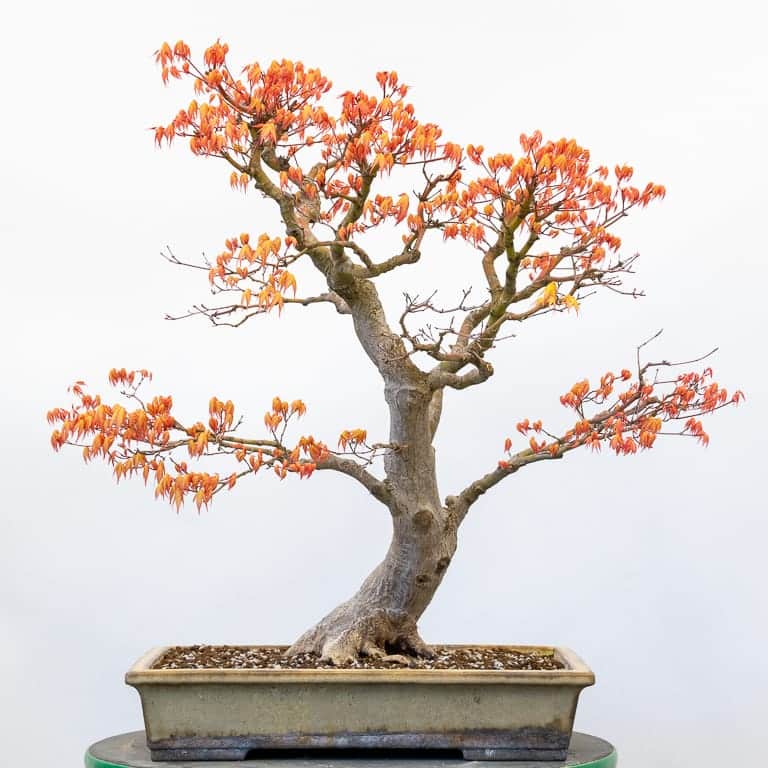
Japanese maple planted in a 50% akadama mix
Pre-Bonsai
For seedlings, cuttings, or trees at any of the earlier stages of development, the decision of what soil mix to use is less important than it is for refined trees as it will be switched out, possibly multiple times, before these trees make it into bonsai pots.
Straight perlite or perlite mixed with peat moss, coir, or other organic ingredients is fantastic for rooting cuttings or sprouting seeds.
Pumice mixed with organic mulches can make a good mix for young trees, and I’ve experimented with 1-1 mixes of pumice and lava rock and even 100% lava rock as this approach has been used to great effect in some gardens in Japan.
For trees collected from gardens or from the mountains, the popular mix of 100% pumice is my favorite as it’s lightweight and I can control the moisture content by using larger or smaller particles (smaller particle mixes hold more moisture than large particle mixes).
I sometimes use akadama-based premixes, but I rarely use more than 30% akadama for conifers or more than 50% akadama for deciduous pre-bonsai. What I’ve found is that more akadama slows growth and I often want faster growth in these early stages of development.
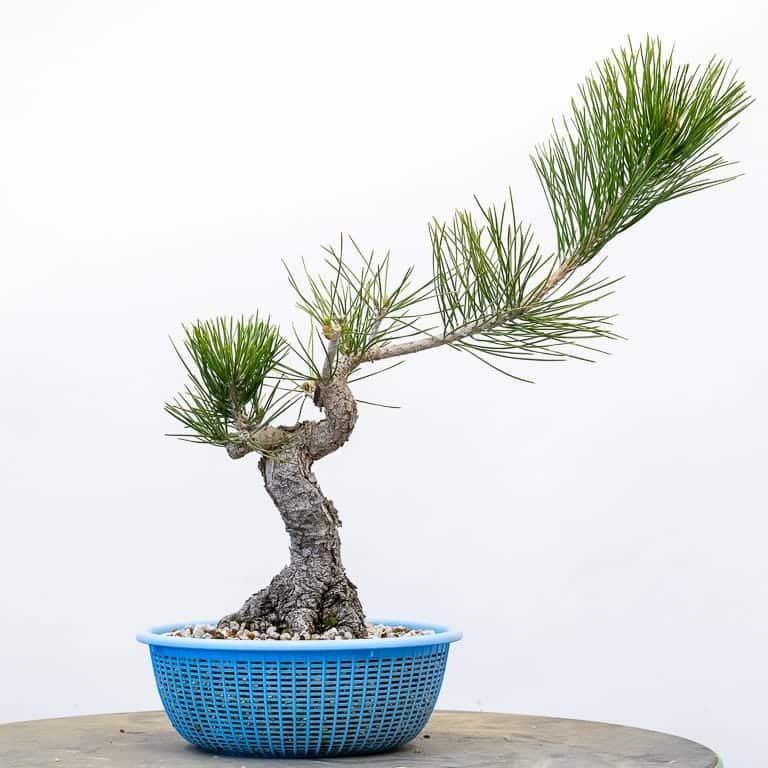
Black pine pre-bonsai in a 30% akadama mix
Tropical Bonsai
I’ve found that tropical bonsai can do well in a variety of mixes. Around the country, I’ve seen different mixes used to good effect. One reason for this is the variety of environments in which tropical bonsai grow.
Many of these trees are grown indoors for at least part of the year which can have a big effect on both the temperature and the humidity they experience. In general, the higher the temperature, up to a point, and the higher the humidity, the easier it will be to keep a tropical bonsai healthy.
I usually use 30% – 50% akadama mixes (the remainder can be pumice and/or lava rock) for tropical bonsai. If a tree stays too wet I’ll use less akadama, and if I want the soil to retain more moisture, I’ll use more akadama.
That said, I have far less experience with tropical bonsai than I do with temperate trees. If this approach doesn’t yield the results you’re looking for, check with others growing tropical trees in your area and experiment until you get the results you want!
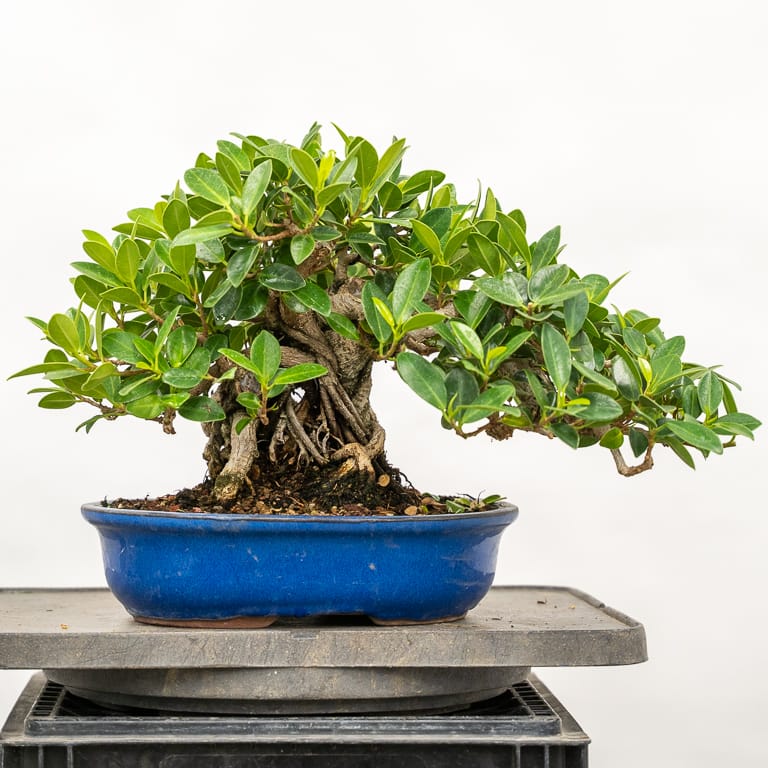
Green island ficus planted in a 50% akadama mix
Broadleaf Evergreens
Broadleaf evergreen bonsai covers a diverse group of trees including native species like live oaks or Yaupon holly, exotic species like eleagnus or privet, and subtropical species like gardenia.
In general, I treat broadleaf evegreen species like deciduous species, but there may be exceptions for the species you’re working with.
Unhealthy live oaks, for example, benefit from drier mixes with high percentages of pumice. Once these trees are healthy again, I’ll increase the percentage of akadama.
Watching for signs of over- or underwatering is the best guide for making adjustments to your basic mixes so you can always make changes until you find what works best for your trees.
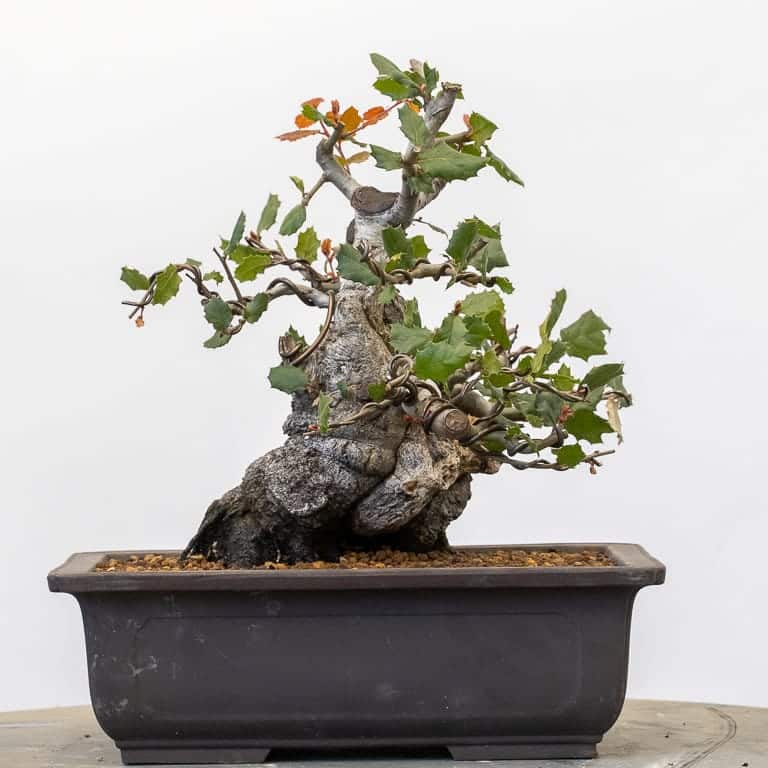
Coast live oak in a 50% akadama mix with 80% akadama top dressing for looks
Azalea Bonsai
The soil mix for azalea bonsai, including satsuki azaleas, is simple: 100% kanuma. This goes for cuttings, young trees, and refined specimens.
It’s possible to grow azaleas in a variety of mixes, but I find it’s easiest to keep them healthy in mixes of 100% kanuma.
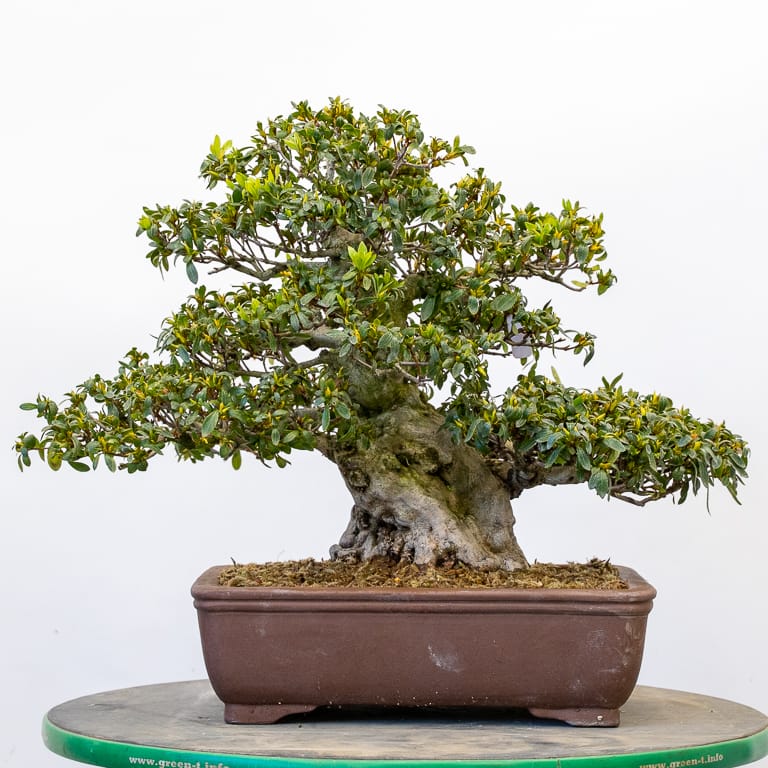
Nikko satsuki azalea in 100% kanuma
Notable exceptions
There are more exceptions than I can possibly include in this post, but I’d like to mention a few common ones (feel free to suggest additional exceptions in the comments).
- Coast redwoods grow well in 30% akadama mixes but they can dry out quickly. Increasing the akadama content in the mix can make it easier to keep redwoods from drying out. I usually use between 30% – 50% akadama mixes for redwood pre-bonsai and 50-80% akadama mixes for more refined specimens.
- Like coast redwoods, cryptomeria and hinoki bonsai can benefit from higher akadama mixes.
- Higher akadama mixes are common for rock plantings and sometimes forest plantings or other arrangements where the trees are repotted less frequently than other bonsai. The additional akadama provides more opportunities for root growth over long periods of time without introducing fresh soil.
- 100% akadama mixes are popular for some species, but I have yet to see demonstrated benefits from this approach over mixes of 50% – 80% akadama, and it can really slow growth in cooler areas where the soil dries out slowly. This becomes even more noticeable as the akadama breaks down which can lead it to hold even more moisture.
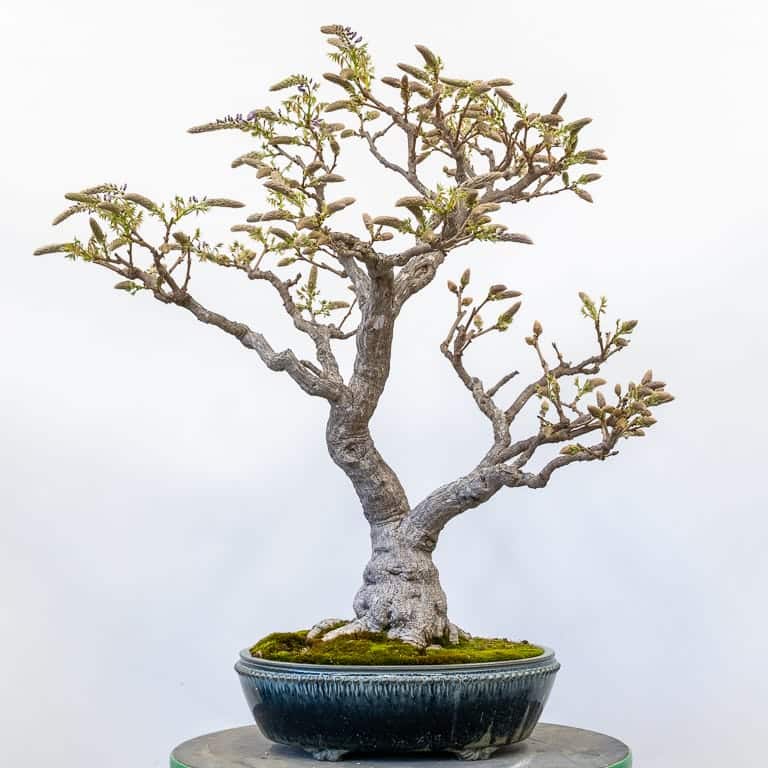
Wisteria in a 60% akadama mix
Final thoughts
If this level of detail sounds challenging and you only have one tree in your collection, you can make just about any soil mix work for your tree if you water carefully and repot regularly (roughly every 2-3 years).
If, however, you’re trying to refine your approach, the above tips may provide a starting point for experimenting with different soils in your garden.
Have additional tips or questions related to bonsai soil? Feel free to leave them in the comments below.
Bonsai Tonight Updates
- If you haven’t heard it yet, the latest episode of the Bonsai Wire Podcast features a technical discussion about repotting with Michael Hagedorn, Andrew Robson, John Eads and me.
- New trees have been added to the Client Tree Sales page.
Subscribe to Bonsai Tonight
New Posts Delivered Every Tuesday and Friday
Michael Corbin says
Jonas,
I really enjoyed this post and the podcast on the same subject. Honestly Bonsai Wire is the best bonsai podcast I have listened to. I look forward to every episode and always learn something.
Can you comment on spruce and larch. I suspect they’d be similar the readwood an hinoki recommendations.
Jonas Dupuich says
Thanks, Michael – I’m glad you’re enjoying the podcast! As for spruce and larch, I don’t have enough experience with them to make a strong recommendation and would defer to others who work with them a lot.
Jeff Aldridge says
Very useful Jonas. Now perhaps a parallel post on shohin bonsai. Particle size and variations in mix relative to container depth would be helpful. Your posts, as always, are most helpful.
Jonas Dupuich says
Thanks, Jeff, that’s a good idea. Particle size and percentage of akadama work together and the balance is subtle when working with small trees. Will make a note for a future post!
Charlie Mosse says
This post and the podcast are excellent references. Passing this around the club for sure. A bit more info on particle size, as requested above, would be terrific. I have found particle size and approximate % of particle to be very important, from personal experience and from what others like yourself have talked about. Thanks for info. Very helpful.
Jonas Dupuich says
Thanks, Charlie! I’ll say more about particle size in an upcoming post – thanks for the suggestion!
Oleh says
Hey. Huge thanks for the great article. I wanted to ask if Kirio is a Japanese pemuce, or its something else and cannot be used instead of it? E.g for seedlings.
Jonas Dupuich says
Thanks, Oleh! Kiryu is like pumice but it’s more acidic. It’s a common ingredient in bonsai premixes so I think it can be used as an ingredient in mixes for seedlings or refined trees.
Oleh Tarasenko says
Hey. Thanks for the answer. By the way I also noticed that seeds in pure akadama are slower compared to those which I have in regular soil. I just wonder why. And why pumice helps them to grow faster?
Jonas Dupuich says
The best I can tell is that soil that retains too much moisture inhibits growth. Young trees need more available air to grow roots.
Oleg says
Hey, thanks for the answers. Sorry one more thing :).
For young trees (seedlings of Acer and ficus benjamin) how fast the soil should dry out? (I was using akadama last year, and they was wet for 4-5 days even outside). Now I am thinking of how to find a correct mix.
Jonas Dupuich says
How fast a soil should dry out is tricky as the “right” answer will change as the weather changes. If the trees frequently wilt, I’d aim for a mix that retails more moisture. If it’s above 80F and the tree only needs watering once or twice a week, a mix that holds less moisture might make sense.
I’ve found that when my trees have similar water needs, it’s easier to keep everything healthy.
Andy says
Any experience with Camellia? My intuition is to go with a strong kanuma mix. Maybe not 100% due to the roots being not quite as fine but still an acid loving plant.
Jonas Dupuich says
Hi Andy! Nurseries in Japan often use deciduous soil mixes of 80% akadama for camellias. I’ve seen them grow well in 1-1-1 akadama, lava rock, and pumice mixes, but I think the higher akadama mixes are good for the fine roots. I’d expect they’d do well with kanuma in the mix, but I don’t know if it’s necessary.
Rutledge Bryan says
Jonas, I enjoy your posts, and I am happy to see my old wisteria doing so well. If you will be at the nursery this week I would like to come down and see your trees.
Sam Bryan
Jonas Dupuich says
Thanks, Sam! I expect the wisteria will be fully open toward the end of the week through next week so it’s a good time to stop by!
Ann Mudie says
Here in New Zealand we have to pay a fortune for Akadama, and can’t get Kanuma at all. Are there any substitutes for Kanuma for my azaleas that you’d recommend?
Jonas Dupuich says
The first thing that comes to mind is to use regular bonsai soil and fertilizer with acidifying properties like fish emulsion or organic meals such as cottonseed meal. I’ve also used bark and lava rock mixes that azaleas seemed to like.
Victor Taboada says
Wonderful post Jonas! Thank you so much for sharing!
Jonas Dupuich says
Thank you, Victor!
Andrew Gutierrez says
Jonas,
I have been practicing bonsai for almost 2 years and have been looking for an article like this. This was perfect! Thank you! My one question is, for a beginner like myself, if I find a regular 1 gallon juniper at a garden center and want to develop it as a pre-bonsai, would it be beneficial to repot into 80% pumice, 20% mulch now or wait after styling it in a year or so?
Jonas Dupuich says
Thanks, Andrew! I’ll cover repotting trees out of nursery soil in an upcoming post. As for your juniper, I’d make the decision based on how much pruning you did and how bad the soil is. I’d likely do the repot but not be too aggressive with root cutting.
Derek White says
Thanks Jonas! I really appreciate all your content. Your detail and experience is so very helpful. Because of you, I was inspired to try growing JBP from seed. So far, I have a few tiny seedlings sprouting up (I live in Florida, so spring is early). I’m wondering if a 50/50 mix of perlite and peat moss would be a good medium to transfer individual seedlings into (likely clipping the tap root and using hormone, as you’ve suggested in some cases). Would be grateful for your guidance on JBP seedlings and soil. Thanks!
Jonas Dupuich says
Thanks, Derek! I might try 20% – 25% peat with the remainder perlite for the young pines. If you’re curious, try some at 50% peat and others at 20-25% peat and see if there’s a difference!